A somewhat permanent, traditional adjustable height desk works wonderfully for some people.
Others are looking for an option making their height adjustable table mobile. So, what do people need to know about those kinds of desks?
I interviewed Bill Knighton, President of RightAngle Products, and asked him to share his experience as a manufacturer and engineer about the vital issues surrounding standing desks with casters.
Throughout this article, I share the critical need-to-know info about adding casters to a standing desk shared by Knighton.
Morphing into Mobile Desks
Purchasing a table with the option of adding casters to the table feet makes your standing desk mobile.
These types of tables are used in classrooms, warehouses, training rooms, or even in your personal office space.
Buying casters for your desk may seem simple. It’s important to know that by adding them, you add a layer of complexity to the desk’s ergonomic function and stability.
There are some key factors to take into consideration when purchasing a mobile standing table.
Does Caster Size Affect a Standing Desk?
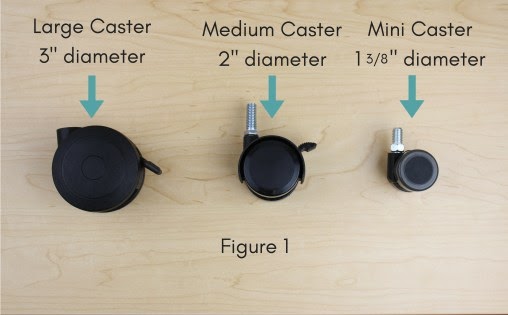
One thing to pay attention to is the size of the caster. There are three:
- A mini-caster with a wheel that’s 1-3/8 inches in diameter
- A medium-sized caster measuring two inches in diameter
- A large caster about three inches in diameter
If attached to a standard foot (removing the foot glides and replaced with casters), the size is a good indication of how much height is added to your table.
This increased height is addressed further in the upcoming section, How Adding Wheels Affects Table Height.
Almost every company offering this kind of office solution has an option for the mini- or two-inch casters.
However, few companies give provide the option of three-inch casters.
Knowing the differences between caster sizes helps determine which option is best for you.
Caster Options
If a table has the standard foot, it is best to add the smaller casters since they add between 1-3/8 inches and two inches of table height
A table that once had its lowest position measuring 27 inches becomes roughly 29 inches when adding a medium-sized caster.
That is better than the three inches gained by using a larger size wheel.
However, smaller casters have a harder time traveling over cracks, bumps, or door thresholds while moving the desk from one area to another.
The small casters get stuck because of those obstacles completely stop the table in its tracks, which causes you to reroute.
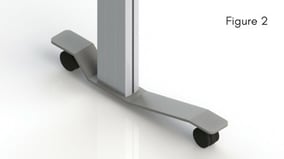
There are a few companies that manufacture a table foot specifically for the addition of casters.
A caster foot reduces the overall increased height when attaching the caster.
Some caster feet are made to fit three-inch wheels while only adding one-half inch to the height of the table.
In this case, the half inch height addition is much better than the 1-3/8 inch to 1-1/4 inches from a mini or medium caster added to the standard table foot.
Additionally, larger casters roll easier when moving the table. The larger size allows the desk to go through bumps and cracks smoothly.
Caster Mobility
If moving the mobile standing desk with three-inch casters into an elevator for transport, you never have to worry about the wheels getting stuck in those large gaps between the floor and the elevator.
That said, casters tend to swivel when moving the desk. This motion changes the distance between the two contact points of the foot. The contact point is the location where the caster wheel touches the floor.
A smaller distance between the points means there is less area supporting the table. This shorter length increases instability.
If comparing two and three-inch casters on the same standard table foot, the larger caster ultimately produces the shortest distance between the contact points.
No single particular caster size is inherently better than the other. It entirely depends on your application and the sit to stand table that you’re thinking of buying.
How Adding Wheels Affects Table Height
“The table height changes when adding casters to a height adjustable table. This decreases the level of ergonomic benefits.”
Bill Knighton
A large of companies merely remove the glides from the standard table feet and screw the casters in their place.
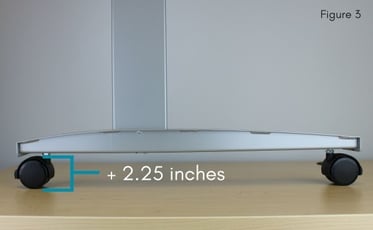
If adding a medium sized caster (two inches in diameter), that adds about 2-1/4 inches to the height of your desk.
If your desk initially had a height range of 27 to 47 inches, the addition of the caster makes the range 29-1/4 to 49-1/4 inches.
That 2-1/4 -inch addition to the table height is likely to make it more challenging to be in an ergonomic position.
Your desk rose 2-1/4 inches higher, but you didn't. This disparity makes it more challenging to find the best ergonomic sitting and standing position.
Raising the area on the foot where the caster mounts make it possible to add a three-inch caster and only to add one-half inch of desk height.
Advantage of Making Your Casters
However, there are only a handful of companies that manufacture their caster foot.
Not all companies making this type of foot use a three-inch caster. Some use the mini or medium-size instead.
When using a caster foot instead of a standard foot, the small height addition to the table makes it easier to find your ergonomic position for both sitting and standing positions.
One-half inch is relatively insignificant regarding adjusting to a proper, ergonomic position.
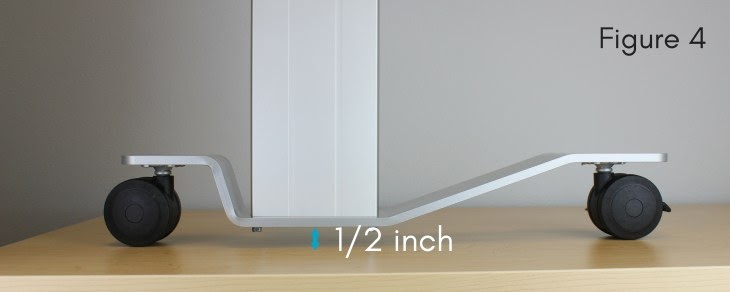
Does Adding Casters Affect Desk Stability?
The simple answer: yes.
Casters compromise stability when added to a height adjustable desk. The entire purpose of having casters on the table is making the unit mobile.
What if you had to lower the table to a sitting height to enjoy the mobility feature? How often will users want to take the time to do that?
Not usually, but a user shouldn’t even have to take the time to do that anyway!
You need to be aware of which table styles require that extra step and what desk components you should pay particular attention to before buying.
Crossbar or No Crossbar
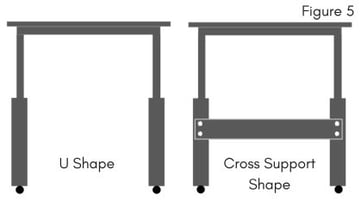
It is typical for companies to produce tables with what Knighton calls a U-shape, as seen in Figure 5.
The U-shape only provides support where the legs are attached to the table.
According to Knighton, when a U-shape table with casters moves across the floor, the legs tend to move in and out.
There’s no support located on the lower portion of the table to prevent the legs from shifting during movement.
What’s stopping the table leg from swaying in or out when hitting a bump or crack on the floor? Nothing.
Cross Support
Prevent shifting legs by using a standing desk with a cross support.
A cross support attached to the lower, non-moving leg columns has the same function as an X brace on a bridge or building. The design helps eliminate lateral movement and ensuring stability.
When you’re moving your adjustable table with caster feet, the desk’s legs won’t move in and out. If you want mobility, it’s never been more important to have a cross support.
Knee-Knockers?
Some competitors say that a cross support decreases the amount of knee clearance on the table, which makes sitting comfortably tricky.
That statement is true if the desk has a T-shaped leg and foot. The T-shape limits the amount of knee clearance when adding a cross support since the legs are in the middle of the table.
However, Knighton said tables with an L-shaped leg and foot are designed to ensure there is a sufficient amount of knee clearance, especially when adding a crossbar for support.
With this shape, the attached leg is further back on the table giving more room for the user’s knees than in the T-shape. The image below helps illustrate the difference between the two leg shapes.
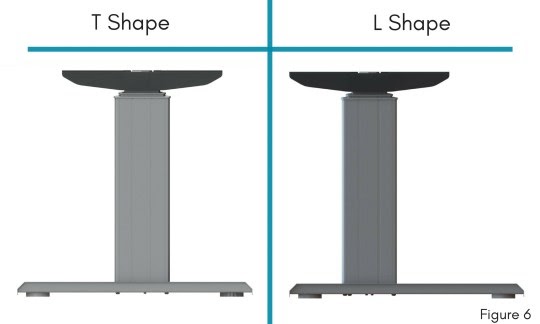
Desk Feet: Bigger is Better
Now, let’s discuss how the addition of casters changes the amount of stability provided by the foot.
To maintain desk stability, Knighton suggests looking for a foot that is close to the same size as the depth of the work surface. For example, if you have a work surface that has a depth of 24 inches, your foot should be at least 23 inches.
A standard foot usually has either two glides or two casters with one placed towards the front and the other towards the back.
The spot where a glide or caster connects to the floor is called the contact, or leverage, point. The greater distance between the front and back contact points results in more stability.
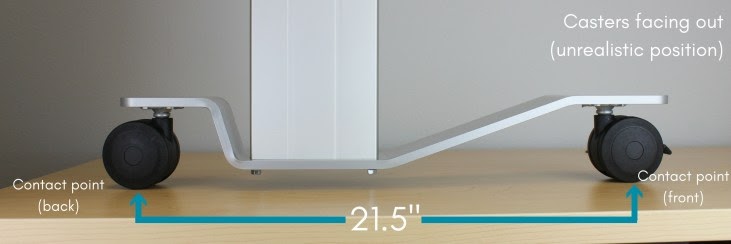
In a perfect world, the two casters on the same foot would be in opposite directions both facing outwards while the desk is both stationary and in motion. The figure above shows a 23-1/2 inch foot with two, three-inch casters facing outwards.
Caster Direction
Having both casters facing the same direction means the distance between the contact points always remains the same in their widest position.
NOTE: Even in this situation, the distance between the points is 21-1/2 inches.
However, it’s pretty much impossible for them to ever be in that position. Instead, the casters swivel while in motion, as shown in the video below.
When the casters swivel, one of two things happen:
- The casters are in the same position
- The casters face towards each other (the Illustration below shows both examples)
In both those scenarios, the distance between the contact points decrease. The length is the shortest when the casters face one another.
When that occurs, the distance between the two contact points can be as little as 20 inches if using three-inch diameter casters.
Even if the entire foot is 23 inches, it now becomes 20 inches providing support to a 24 inch top.
This difference increases the amount of table wobble. A wobble is much less likely to occur if the table is in its lowest position.
However, as you increase the height of the table or begin to roll it across the floor, that 20 inches leads to a noticeable amount of wiggle and instability.

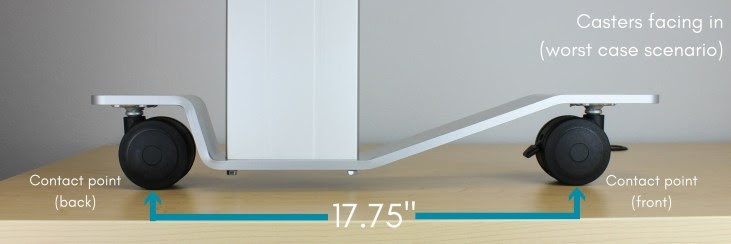
If you choose to go with a workspace that is 24 inches deep, I suggest using smaller casters on a foot that’s at least 23 inches.
The smaller casters ensure the distance between the contact points doesn’t get too short while maintaining more stability.
Even though a 24 inch depth work surface can be fitted with casters, Knighton stresses and highly suggests purchasing a desk that’s 30 inches in depth with a foot that’s at least 29 inches.
This extra foot length directly increases the distance between the two contact points of the foot.
“One of the most important aspects of a desk, especially one that’s height adjustable and mobile, is stability. The larger work surface and foot, the better the stability you’ll have. Also, use larger casters. They provide easier roll and are less likely to get stuck or be stopped by cracks or bumps.”
Bill Knighton
RightAngle Products and Casters
Towards the end of the interview, I asked him to explain how RightAngle Products chooses to manufacture height adjustable tables with casters.
“RightAngle is one of the few companies who manufacture their caster foot,” Knighton explained. “We use a three inch wheel for easy mobility and the capability to travel over large cracks and rough surfaces.”
The company specifically engineers and manufactures their caster foot, so it adds as little height to the standing desk as possible. Even when using the 3 inch wheel, RA’s caster foot adds a one-half inch to the table height.
Maintaining Ergonomics
It’s essential to Knighton that his products are as ergonomic as possible, while also providing his customers with options fitting their specific needs.
Adding casters and making a standing desk mobile shouldn’t lessen the ergonomic properties of the product, and the RightAngle caster foot makes that possible.
As previously mentioned, adding a cross support keeps the table legs from shifting and maintain a high level of stability.
Knighton promises that RightAngle only sells caster standing desks with cross supports.
“I believe that it’s in the best interest of the customer to maintain stability and sturdiness within the desk.
I had mentioned earlier that there is the mistaken belief that when adding a cross support to the desk, there isn’t enough knee clearance. Using the L-shape leg solves that issue.
RightAngle Products is one of the companies that use the C-leg shape providing the necessary amount of knee clearance, while still adding a crossbar for added support and stability.
Final Suggestions
When looking for a standing desk with casters, make sure to:
Pay attention to the added table height using casters. Keep in mind: the smaller the height addition, the better.
Adding more than one-half inch to the table height from casters decreases the ability to be in an ergonomic position.
Look for a cross support with an L-shaped leg.
Find a standing desk base that has a table leg no more than one inch shorter than the table work surface depth— for example a 30-inch deep work surface with at least a 29 inch foot.
Keep in mind that a more substantial desk is better since it ensures more stability: if you follow the above suggestions.

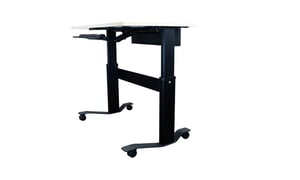
COMMENTS